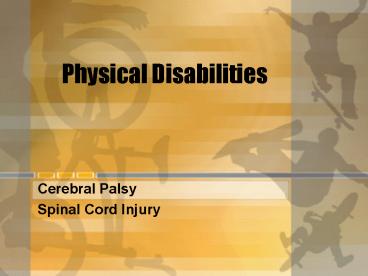Physical Disabilities - PowerPoint PPT Presentation
1 / 15
Title: Physical Disabilities
1
Physical Disabilities
- Cerebral Palsy
- Spinal Cord Injury
2
Cerebral Palsy
- Medical term that refers to one of a series of
motor disorders that stem from brain malfunction - Damage to the immature brain
- Retention of Primitive Reflexes
- Asymmetric Tonic Neck Reflex (ATNR)
- Symmetric Tonic Neck Reflex (TNR)
- Incidence - 7/1000
- Characteristics -
- Non-hereditary, non-contagious, and
non-progressive - Cause - time of onset
3
(No Transcript)
4
Cerebral Palsy Causes and Characteristics
- Prenatal
- Functional disturbances of the mother (may
produce hemorrhages in fetal brain) - Rh incompatibility
- Infection
- Perinatal
- Diseases
- Prolonged or difficult labor
- Anoxic conditions
- Premature birth
Accounts for 90 of all Cases
5
Cerebral Palsy Causes and Characteristics
- Postnatal (10)
- Brain infections
- Poisoning
- Head trauma
- Types of Cerebral Palsy
- Mild to severe
- Based on muscle tone and limbs involved
- 7 distinct types of CP (5 most common)
- 5 anatomical classifications of limbs involved
6
Five Types of Cerebral Palsy
- Spastic - hypertonic muscle tone
- Scissors gait and Hemiplegic gait
- Athetoid - fluctuating muscle tone or dystonia
- Ataxic - deficient sense of balance,
coordination, and kinesthesis - Cerebellar/kinesthetic gait
- Hypotonia - Low muscle tone (hypotonia)
- Mixed - combination of types (most common
spastic/athetoid)
7
Adapted Devices
- Wheelchairs - VIDEO
- regular
- sport
- electric/manual
- Braces (AFOs, KFOs, AKFOs)
- Canes -
- T, J, Quad
- Crutches / Walkers
- Team Hoyt video link - http//www.youtube.com/wa
tch?vf4B-r8KJhlE
8
Anatomical Classification for Limbs Involved
- Monoplegia -
- Diplegia -
- Hemiplegia -
- Triplegia -
- Quadriplegia -
9
Practical Applications
- Wheelchair positioning
- Transfers
10
Spinal Cord Injury (SCI)
- Incidence
- Approximately 10,000 each year in U.S.
- Two categories of spinal cord injury
- paraplegia
- quadriplegia
- Higher lesions less function
- High variability depending on complete or
incomplete
11
(No Transcript)
12
Spinal Cord
- Spinal cord 31 pairs of spinal nerves
- Protected by vertebral column
- 24 movable
- 7 cervical
- 12 thoracic
- 5 lumbar
- Spinal cord injuries result from some type of
trauma - Movement and Sensation -
13
(No Transcript)
14
Spinal Cord Injury Classification
- Five-point grading system for extent of injury
(lesion to spinal cord) - Complete
- Incomplete with sensation only
- Incomplete with nonfunctional motor ability
- Incomplete with motor function
- Complete recovery
15
Concerns with Spinal Cord Injury
- Sensation and Skin Breakdown -
- Temperature Control -
- Contractures -
- Spasms of Spinal Origin -
- Atrophy of Limbs -
- Urination -
- Sexuality -
- Heart and Circulatory Concerns -
- Autonomic Dysreflexia -
- Weight Management and Osteoporosis -
- Depression -































